The most popular man-made material isn’t steel, plastic, or aluminium — it’s concrete. But what the heck is concrete, really? That may sound like a silly question, but most of us don’t actually know. Do you? If not, read on, because we have the answer.
When we think concrete, we usually picture white pavements, swimming pools, and building foundations. But most of us aren’t aware of concrete’s fiery volcanic origin story, or that concrete is a $100 billion dollar industry and the most used material on planet Earth after water.
Here’s the surprising truth about the overlooked material that built the modern world.
A Simple Definition
Unlike aluminium, steel or plastic, the word ‘concrete’ doesn’t refer to a single material. Rather, it encompasses any number of composite materials that meet some simple criteria. Here’s the Merriam-Webster take:
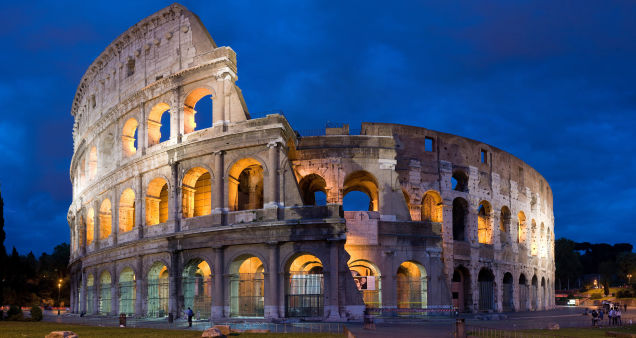
So basically, concrete is just a bunch of rocky stuff mixed with water and cement. Together, these ingredients form gravelly jello that can be poured into a mould and shaped into whatever the heck you like. Liquid stone, it’s sometimes called. We totally take this for granted today, but in ancient times, when people were literally hand-carving buildings out of giant slabs of rock, you can bet your bricks a material like concrete would have seemed downright magical.
There’s evidence that humans have been tinkering with concrete for thousands of years. But it was the Romans who really mastered the craft, and they probably learned about it from volcanoes.
Born in a Fiery Volcano
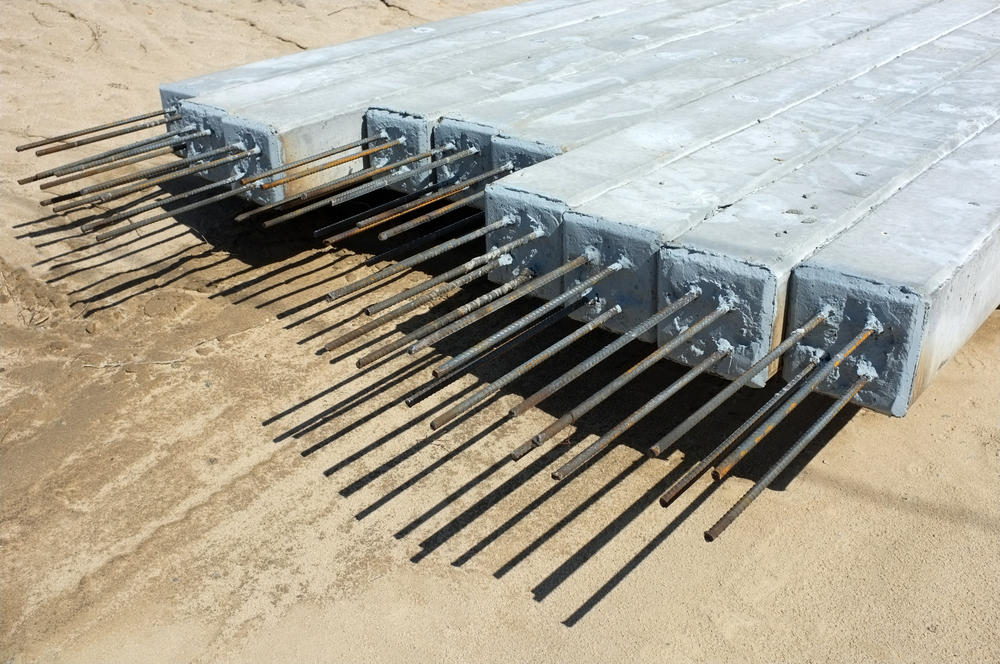
The Colosseum, a famous Roman concrete structure, via Wikimedia
Magical rings and Valyrian steel aren’t the only things forged in volcanoes. So was the template for the material that would build the modern world.
During the height of the Roman empire, the port city of Pozzuoli was a buzzing center of military activity and commerce. Every day, ships left Pozzuoli laden with useful goods, including grains, iron, weapons, and pozzolana, an ashy volcanic sand formed in the nearby supervolcano Campi Flegrei.
Why were the Romans exporting volcanic spew to the far corners of the known world? It so happens that this sand was special. Mix it with water, and it would form a mortar strong enough to bind lumps of rock together into an impenetrable, load-bearing material. As Roman philosopher Seneca noted, the “dust at Puteoli [the city’s Latin name] becomes stone if it touches water.” Nobody knew why.
By sheer luck, the Romans had built a city atop a natural cement factory. Turns out, pozzolana is a mixture of silica oxides and lime, two of the three key ingredients in cement (the third being water). It wasn’t until this year that a Stanford geochemist worked out how this unusual ash forms.
The deep interior of Campi Flegrei’s caldera is padded in limestone, a soft, crumbly rock composed of calcium carbonate (CaCO3). As geothermally-heated water washes over the caldera’s limestone walls, it triggers a decarbonation reaction, releasing CO2 gas and leaving behind calcium hydroxide, otherwise known as hydrated lime. Here’s the reaction describing that process:
CaCO3 (limestone) + heat + H2O > Ca(OH)2 + CO2
Circulating geothermal fluids inside Campi Flegrei bring some of this lime closer to the surface, where it combines with silica-rich ash to form an impenetrable, cement-like caprock. But eventually, enough pressure builds up inside the volcano that this caprock bends and breaks. When that happens, the same cement-forming ingredients spew skyward, as pozzolana ash.
Geochemist Tiziana Vanorio suspects the ancient Romans first watched pozzolana hardening into cement in the seawater surrounding Campi Flegrei. They co-opted the natural process, mixing in small chunks of pumice — a porous volcanic rock that forms when superheated magma is quickly cooled. And just like that, Roman concrete was born. It became an iconic building material of the ancient world, and it’s the reason many Roman structures, including the Colosseum and the Parthenon, have survived to the present day.
After the fall of the Roman empire, the art of concrete-making was all but forgotten. It gradually returned centuries later, but didn’t become widespread again until 1824, when Joseph Aspdin developed and patented Portland cement.
The main ingredient in Aspdin’s cement? Calcium silicates, formed by heating limestone and silica-rich clays in an oven to roughly 1,100ºF. Just as Campi Flegrei had been doing for thousands of years.
Modern Varieties
Today, Portland cement is quite literally the glue that holds the world together, forming the basis of concrete, mortar, stucco and grout. The main post-Roman Empire innovation was the addition of aluminium and iron oxides, which add strength and allow the calcium silicates to form at lower temperatures.
Here’s a general recipe for Portland clinker (the dried, powdery version of cement). Proportions vary by application, depending on the desired material properties of the cement.
| Cement | CCN | Mass % |
|---|---|---|
| Calcium oxide, CaO | C | 61 — 67% |
| Silicon dioxide, SiO2 | S | 19 — 23% |
| Aluminium oxide, Al2O3 | A | 2.5 — 6% |
| Ferric oxide, Fe2O3 | F | 0 — 6% |
| Sulfate | S̅ | 1.5 — 4.5% |
CCN = Cement chemist’s notation. Via Wikipedia
But remember! Concrete isn’t just cement. This is where things get a bit complicated. In modern times, we’ve discovered a plethora of additives that can be useful depending on whether you’re trying to build a highway overpass, a dam, a reservoir, a runway, a boat, or a building. There are additives that increase concrete’s electrical conductivity, strength, ductility, and resistance to acid corrosion. There are chemical retardants that slow concrete’s hydration, accelerators that speed it up, and plasticizers that increase its workability. There are corrosion inhibitors. There are pigments. There are decorative stones and seashells.
Concrete is actually a mess. I’ll spare you the encyclopedic details and just touch on a few important, interesting, and futuristic varieties that I think are worth knowing.
Reinforced Concrete
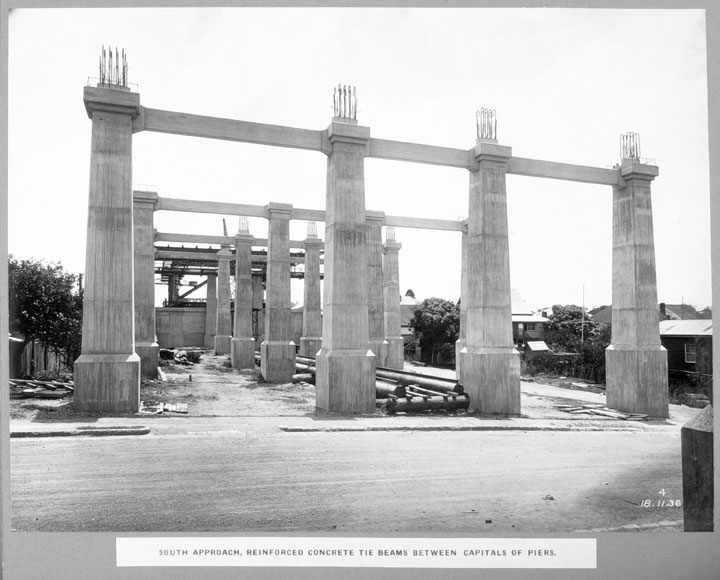
Concrete pilings with steel reinforcement. Image via Shutterstock
Concrete has high compressive strength, meaning it can hold a lot of weight without getting crushed. This makes it an excellent material for building and road foundations. But concrete gets bad marks for tensile strength. If it bends, it cracks. This is no bueno for bridges, beams and columns. To improve concrete’s ductility, we add steel bars, glass or plastic fibres before it sets. This is called reinforced concrete.
The Romans kinda figured this one out too. They used to add horse hair to concrete to keep it from cracking while hardening.

Reinforced concrete tie beams between capitals of piers, Brisbane. Image via Wikimedia
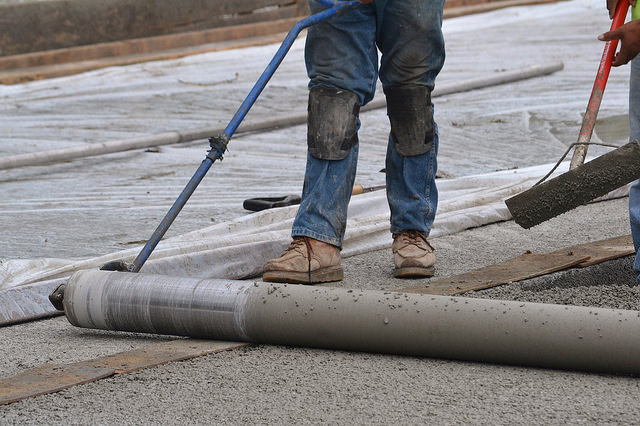
The Philips Pavilion, a World’s Fair pavilion designed for Expo ’58 in Brussels, was made possible by reinforced concrete. Image via Wouter Hagens / Wikimedia
Pervious Concrete
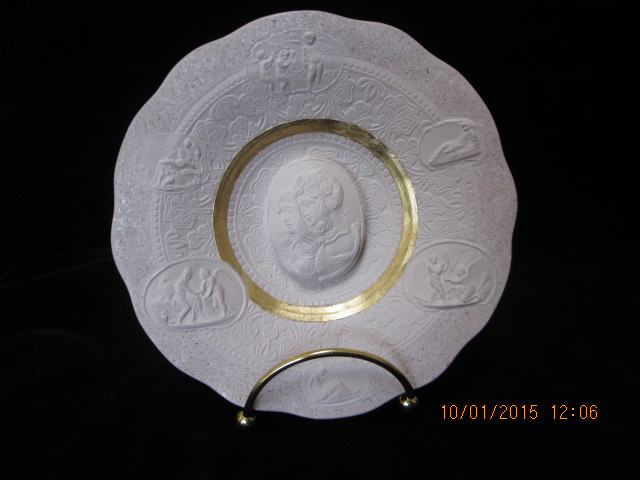
A pervious concrete parking lot being installed in Chicago. Image via Flickr
Most concretes form an impervious surface, meaning water hits ’em and runs right off. Pervious concrete, also known as porous pavement, does the opposite — its larger particles allow precipitation to seep all the way through to the ground. This is actually a great idea, because impervious surfaces cause urban flooding and contribute to stormwater pollution. In the future, pervious concrete is going to become an important part of the sustainable infrastructure landscape.
Nano Concrete
When you mix cement, sand, and water at high energies, particles start flying around super fast, colliding with each other and shearing apart. Eventually, you’re left with a mixture of tiny, nanoscale grains. This is called nanoconcrete. Thanks to its very small particle size, nanoconcrete has a high surface area to volume ratio, which allows it to absorb a lot more water than regular concrete. More water means a fluffier, lighter material that can be used to cast small architectural details and decorative items, such as this lovely plate:

Decorative plate made of nanoconcrete. Image via Wikimedia
Nanoconcrete isn’t widely used today, but it’s interesting from an economic and environmental perspective. Hydrating the heck out of concrete allows you to stretch the material further, which ultimately reduces the per-capita carbon emissions (the heating process involved in calcium silicate production represents a whopping 7% of our global CO2 emissions). Hey, as long as it doesn’t crumble apart, sounds swell to me.
Microbial Concrete

Diatoms are one of the prettiest examples of biomineralization in action, precipitating glassy exoskeletons around their tiny bodies. Image via Wikimedia
This is definitely my favourite type of concrete, and possibly one of the coolest materials ever imagined. Certain bacteria, including Bacillus pasteurii, Bacillus pseudofirmus, and Arthrobacter crystallopoietes actively precipitate crystals around their cells in a process known as biomineralization. Along with sugar and protein secretions, these minerals form a strong and sticky glue. A few years back, some clever scientists got it in their heads that biomineralizing microbes might help us build stronger, more corrosion-resistant, perhaps even self-healing concrete.
So far, research results seem promising. If this technology ends up taking off, the infrastructure of the future might literally be alive.
Fast Facts About Concrete That will Make You Look Smart
- Concrete is the second most widely consumed substance on Earth, after water.
- Tonne for tonne, humans use more concrete today than steel, wood, plastics, and aluminium combined.
- Worldwide, concrete is a $US100 billion dollar industry.
- Concrete can be moulded into any shape and texture under the sun. Concrete is a shapeshifting chameleon.
- Adding blood to concrete makes it more frost-resistant. Don’t ask me how I know.
Contact the author at maddie.stone@gizmodo.com or follow her on Twitter.
Top image via Shutterstock
